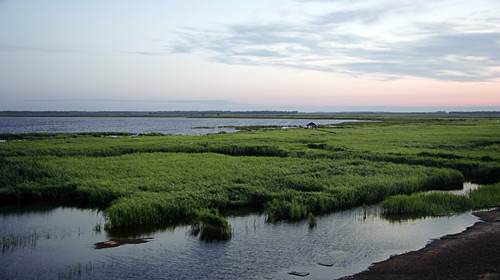|
 |
|
PRISTINE VIEW: Zhalong National Nature Reserve on July 29 (WANG XIANG) |
The red-crowned crane is considered more vigilant than other cranes. They can detect even the weakest sounds and the slightest signs of danger. They form long-term mating pairs that engage in "monogamous marriages," which are not broken until death. If one of the birds dies before the other, the surviving partner will remain single for the rest of its life.
The red-crowned crane is also a bird that maintains high standards for choosing a mate. It will not intermarry and the male will usually choose a female that is one or two years older than him. When two birds pair up, they will sing and dance to each other before the bond becomes permanent.
Two methods have been adopted in Zhalong to release the artificially bred cranes into the wild. The first is called scattering breeding. As the human-bred cranes reach their sexual maturity and find mates to become reproductive couples, they are let out of the breeding cages and return to the wild.
Breeders feed them in the daytime with food and when night falls they go back to the lakeside to spend the night.
"They spend the whole winter this way. The next spring they have babies in the wild, and they live with the wild cranes. In autumn they migrate to the south, finishing the process of becoming wild if there are not any human disturbances," said Wang. There have so far been 12 couples in the scattering-breeding program that have produced more than 10 baby cranes.
The second method to release bred cranes is by freeing them. To ensure their smooth return to the wild, breeders at the reserve train the baby cranes to fly everyday. The 163 baby cranes are teamed up in five age-based groups. The training is open to bird-watching tourists, who number 150,000 each year.
Wang said the next important bit of research is to understand the connection between scattering-breeding cranes and wild ones. "Scattering-breeding cranes will occupy the nests of the wild ones. Too many bred cranes might affect reproduction rates of wild birds," he said.
"Work must also be done to monitor the hydrology, birds, and green vegetation," said Wang. Researchers will monitor the places where cranes reproduce, where they stop along their migratory routes and where they overwinter. Those results, he said, will be evaluated to promote and improve their methods.
Saving the wetland
From 1999 to 2002, a severe drought hit Zhalong and the Wyuer River basin, its water supply. Only 130 square km of the 700-square-km core area remained wet. In 2000, a wildfire lasting a dozen days almost destroyed the wetland ecosystem. The next year, the local government raised funds and diverted 35 million cubic meters of water to the Zhalong wetland, which saved the shrinking 130-square-km wet area. In April 2002, the water diversion project was completed, and added 350 million cubic meters of water to Zhalong.
| 